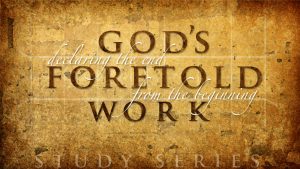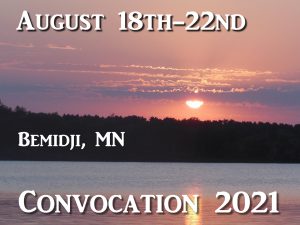by Reggie Kelly
I realize I’ve said as much many times before, but feel this needs more urgently to be stressed now than ever. By its nature, my calling and part in the Body has exposed me, far more than I could wish, to the inner workings of many strong and compelling lies that powerfully oppose and threaten the church’s readiness to escape the unparalleled deception that Jesus said would both precede and accompany the unequaled tribulation.
Even now, throughout the far greater part of professing Christendom, the tribulation without parallel or equal is believed to be past. The tribulation has come and gone with the Roman destruction of Jerusalem in 70 A.D. A fast-growing (two related words like this become one hyphenated adjective) community called ‘preterist’ believes that Jesus’ promised return “immediately after the tribulation of those days” has also come and gone, some stoutly affirming that the resurrection is also past. This, since Dan 12:1-2 so unequivocally connects the resurrection to the unequaled tribulation.
A less popular but still thriving view, particularly among Adventist groups, is the so-called ‘historicist’ view of Revelation. This view sees the ‘great tribulation’, not as a brief period of time at the the end, but as stretching out to include either all or most of the inter-advent period. Many historic premillennialists (an accepted prefix – no need for a hyphen) view the half week (the 3 1/2 years of Daniel and Revelation) (delete comma – parentheses function as commas) as beginning with the ascension, basing their view on Rev. 12’s imagery of the catching up of the man-child, followed immediately in vision by the great tribulation.
Many, perhaps most, (add comma) evangelical lovers of Israel who see a future Antichrist invasion of Israel (delete comma between long subject and the verb) do not expect to be directly impacted by the last great deception. This is because they expect to be raptured to heaven where they will be celebrating the marriage supper while the Jewish people are experiencing their greatest hour of anguish without the church’s witness. This means that those living on this side of the rapture will not be so critically and decisively benefited by taking close heed to Jesus’ directive to read and understand Daniel in order to escape the deception that would imperil the very elect.
But if the church is exempt from the great tribulation, who then are the persecuted saints described in Daniel and Revelation? We are told these do not belong to the body of Christ, nor do they become part of the body of Christ when they are saved. Rather, it is supposed that the persecuted believers of the tribulation belong to another people of God altogether, with a different hope and destiny that is distinct from the hope and destiny of the church.
On this view, Jesus’ directive to carefully search out the meaning of Daniel’s prophecy will only be of vital relevance to those ‘left behind’ to face the dangers of those days. However, if this view is in error, it threatens to rob God’s people of vital preparation and protection from a deception so great as to threaten the very elect. Regardless then of one’s view, any fair-minded student of scripture should at least appreciate the reasonable cause for concern, at least taking stock of what is ultimately at stake in one’s perspective on the time and meaning of the tribulation and the question of the church’s relation to it.
Of all the competing views, the one that most insults and slights the sacred trust of the canon, and the Reformed doctrine of the perspicuity of scripture, is the lazy indifference that comfortably proclaims that it is impossible to know much that is definite or certain when it comes to eschatology. But it is Jesus Himself that prescribes with utmost clarity and simplicity what I like to call, “the plain man’s plain path through the millennial maze.”
Even before understanding the ‘what’ or the ‘when’ of the great tribulation, before discovering its approximate duration and then, most importantly, its meaning and purpose – even before knowing what the abomination of desolation might be – there is one simple directive that Jesus gives towards escaping the great deception that would threaten, “if possible”, the very elect. In Mt 24:15, Jesus is basically shouting, “pay attention to Daniel!” But much more particularly, He directs His sheep to one specific event that Daniel describes in considerable detail. In sum, He commands us to go to Daniel, find this particular event, “the abomination of desolation”, and to be careful that we understand what we read.
The reasons for this simple obedience will prove most crucial, not only towards escaping the great deception, but to a glorious unfolding of the whole sweep of God’s costly investment in scripture and history by which His Name is most fully glorified in all the earth. A knowledge of the relation of final things to the seedbed of covenant and promise is crucial for the church’s greater vision of God.
Jesus well knew this signal event to be the key to understanding the unsealed vision, which those with understanding (the maskilim of Dan 11:32-33, 35, 12:3, 9-10) would be proclaiming to Israel and the nations during the last persecution. According to Rev 7:9, 13-14, the testimony of tribulation saints will result in the evangelization of a vast number that will be saved out of ‘the tribulation, the great one’ (Rev 7:9, 13-14). The use of the double definite article in the Greek text is strong evidence that this is not tribulation in general, the common experience of all Christians in this age (Jn 16:33; Acts 14:22), but much more specifically, the great tribulation in particular.
Moreover, when one traces the oft-recurring theme of a final, unequaled tribulation and its centrality in the plan of God, beginning with Moses’ first mention in Deut 4:29-30, so much opens up concerning the nature and goals of God’s covenantal structure of history, and the conflict that rages over the authority of the Word, not only as to the moral and spiritual claims of the covenant, but particularly that greatest of all offenses, most calculated to test and reveal the heart, namely, God’s sovereign prerogative to choose as He will choose. This deep-seated protest and presumption of entitlement traces all the way back to Satan’s original envy (Ps 2; 48:2; Isa 14; note esp, verse 13; Eze 28). It is the basis of all antisemitism. It is why the Antichrist will be encamped on Mount Zion when the Lord returns (Dan 11:45).
I believe that at least part of the problem lies in what we bring to the scripture. When many read the Lord’s plain directive in Mt 24:15, they do not read it with virginal simplicity. “I will go to Daniel and read of this event and pray to understand”. Too often, there are already preconceived notions that have predetermined what one will find, and even much more, by what one must NOT find.
When we obey this all-too-neglected directive (“let the reader understand”) with an honest and open heart, uninfluenced by preconceived notions, we are only part way there. It is here we learn that revelation, skill, and insight came to Daniel when he “set his heart to understand” (Dan 10:12), just as the prophets before and after him would “inquire and search diligently” (1Pet 1:11). We are called into the fellowship of mysteries that require searching out with intense, holy desire, not for pragmatic self-interest, not even only for the purpose of avoiding deception. We are to have the attitude of “come and see” regarding the place of His dwelling, the beauty of His courts, and the secrets He has reserved for His friends. Our passion must be His glory, His wondrous handiwork, His costly investment, His manifold wisdom — and His greater glory in the fellowship of a ‘hidden wisdom’ ordained to our glory.
It is therefore most interesting how the mysteries of God can be so well hidden in such plain sight. It is not that they are intellectually obscure. On the contrary, there are basic protections built right in by the way that scripture interprets scripture. We will take for our best example what we find when we very simply obey Jesus by going to Daniel to look for the abomination of desolation. Jesus well knew that by so doing, we would discover, not only the meaning of this particular event, but very importantly, add comma what precedes and what follows.
By setting this initially strange, but ultimately strategic prophetic signpost at the end of Israel’s long history of covenant and promise, so much more of the overarching plan of God comes into much clearer light. It is no wonder then, comma that Daniel is situated at the center of the seven millennia of God’s prophetic schema of history, the “middle of the week”, so to speak. Interestingly, when Daniel asks, “How long till the end of these wonders?”, we understand the primary application will be the final 3.5 years, but another viable, perhaps dual, comma application would be that from Daniel’s place in history, there would be 3 1/2 millennia till “all these things would be finished”. On that view, which I think compelling, this would include the thousand-year reign of Christ and His saints.
Jesus well knew that this simple obedience would be the key that opens up, not only the order of the signal events of the end, but delete comma as noted, Daniel’s prophecy establishes the eschatological framework for the whole sweep of redemptive history from Genesis to Revelation. So, what do we find concerning this event that will prove such a protection against deception and a key to opening up and setting in right order the greater framework of prophecy? I submit it is by a simple refusal to separate what God has joined.
I cannot here begin to confirm by example, but in all my study, every system of prophetic interpretation (no comma) of which I’m aware (no comma) very obviously goes off at one of three places. Each of these is an example of separating what God has joined, but only by great violence to the text. I can only show a couple of examples.
The abomination of desolation is mentioned four times in Daniel (Dan 8:11; 9:27: 11:31; 12:11). In all four places it is accompanied by the removal of the regular, daily sacrifice. In Dan 12:11, the sacrifice is taken away 1290 days from the time that Daniel and all the righteous are raised from the dead (Dan 12:1-2). In Dan 9:27, the sacrifice is caused to stop at the midpoint of Daniel’s final week. This is 3 1/2 years from the end.
We must remember that Daniel was looking for the end of exile and the coming of the kingdom promised in the prophets before him. He is desperately seeking to understand when this tragic history would give way to kingdom glory. He is asking, “How long to the end of these wonders?” (Dan 12:7).
In Dan 9:24-27, Daniel had learned of the 70 weeks (for the readers unfamiliar with the shorthand) that Israel would be required to wait for the “coming in of the everlasting righteousness”, which would be the righteousness of the promised kingdom of David. This is the righteousness of the New Covenant that Jeremiah anticipates to come at the end of the period that he calls, “the time of Jacob’s trouble” (Jer 30:6-7).
This is the tribulation without equal, which the earlier prophets so commonly associate with the day of the Lord that ends a brief time of unparalleled national affliction and travail. Daniel will put the unequaled time of trouble at the end of the 70th 7, more particularly the second half of the last seven. In keeping with Jeremiah and the earlier prophets, Daniel puts the great transition between this age of covenant wrath and the coming age of kingdom peace and righteousness. He manifestly did not see the age between. This belonged to the mystery that would not be fully revealed and understood until the Spirit would be poured out at Pentecost (Rom 16:25-26; 1Pet 1:11-12)
But here’s what is too seldom observed or considered. In order for Jesus’ prophecy of the end to be fulfilled according to Daniel’s reference to the abomination of desolation, there MUST be a sacrifice that is stopped approximately 3 1/2 years before the final persecutor is destroyed and the dead are raised (Dan 12:1-2, 7, 11).
Likewise, in Dan 9:27 the half week begins when the sacrifice is stopped. Is the “end” that ends the half week of Dan 9:27 the same “end” that brings the deliverance of Daniel’s people and the resurrection of the righteous in Dan 12:1-2, 7, 11, 13? That is a question to be decided, but you can see how God has wisely given us pieces to a puzzle, but not without also providing us a plain path through it.
What and where is this sacrifice? Neither Jesus nor Paul specifically mentions the sacrifice, but both speak of a great violation and desecration that takes place in the temple in Jerusalem (Mt 24:15-16; 2Thes 2:4), as John will associate the temple to the final treading down of Jerusalem in Rev 11:1-2, again describing the half week of Daniel’s prophecy. There is no need to specify the sacrifice since Daniel has supplied this at every mention of the abomination. And it is clear that a temple service in the ‘holy place’ in Jerusalem is not going to exist without a sacrifice, which, of course, cannot continue beyond the point that the Antichrist imposes himself.
Stubbornness enters in when such things as presuppositions and preferences, even fears induced by taunts and the gross caricatures of a convenient ‘guilt by association’, are permitted to bias an objective handling of the evidence. All of this works to hinder us from making the otherwise obvious connections. The Lord sets a wise and perfect trap, particularly in the Word itself, for the pride of self-reliance and the momentum of uncrucified presumption. The interpretation of scripture is itself a test of the heart.
It is the power of our presumption that short circuits our objectivity, breaking the otherwise obvious connections. For example, where in 52 A.D. (add comma), when Paul is writing his second epistle, would the ‘temple of God’ be understood to be standing? It is preposterous to imagine that apart from any qualification to the contrary, Paul would have expected the Thessalonians to have any other kind of edifice in mind but the one in Jerusalem, particularly since he is so plainly ‘re’-establishing the same order of events revealed in Daniel, rehearsed during his earlier visit, and referenced by Jesus. This is even further confirmed by noting Paul’s use of language taken over from the Lord’s Olivet prophecy (compare, “our gathering together unto Him” 2Thes 2:1) where Paul is quite obviously citing Jesus’ well-known reference to the “gathering together of His elect” (Mt 24:31).
Particularly in view of all that both testaments affirm of the climactic day of the Lord, it becomes quite impossible, even exegetically dishonest, to try to separate the resurrection of the righteous from the tribulation of the half week in Daniel and Revelation. This is why those who believe the tribulation passed with 70 A.D., but believe the resurrection is yet future, are called ‘partial preterist’. In contrast, those who believe delete comma not only that the tribulation is past but that the resurrection is also past, call themselves “consistent preterist”, for good reason.
But before all the confusion and debate, it is plain for all to see what Daniel would have understood from his own prophecy. Go and learn what Daniel had inherited from the prophets that went before him, (add comma) who prophesied of these same events and goals of covenant and promise. For Daniel, the end of the 70 7’s could only mean one thing: add colon the end of gentile domination over captive Israel and the long expected (rightly expected) “post-tribulational” kingdom of God on earth. To suppose otherwise exposes a interested (unobjective?) bias, apparently formed by presumptive prior conclusions. It is not enough to say that this was merely the immature hope of OT believers, since the basic order is clearly re-affirmed in the NT (Mt 24; Mk 13; Lk 21: Acts 3:18-21; Ro 11:25-29; 2Thes 2; Rev 6-20).
This has gotten too long for any but the most patient and determined, but you see my point. The neglect to follow through on the Lord’s prescribed means of ‘understanding’ is not, of course, a blanket panacea against every possible form of deception, but it is going to be necessary. It is necessary now, not only for preparation against the ultimate deception, but for the much fuller picture of the overall context of the gospel, what I like to call, “the glory of the story”.
It will be required of the church….or will it?. This raises the crucial question of the relation of the rapture to the resurrection of the OT saints, another example of separating what God has joined. This squabble of comparatively recent origins significantly appears just in time to stand between a complacent Laodicean church and readiness to be those ‘maskilim’ who have the key of interpretation that can instruct many and turn many to righteousness (Dan 11:32-33; 12:3).
That this task should be delegated to a company that has only recently come to faith (no need for elders?) defies the biblical conception and definition of the body of Christ. It especially defies Paul’s definition of the church (defined as the corporate assembly of regenerate saints), as “the pillar and ground of truth”.
Once the context has been restored, we can begin to ask the very important question of the church’s role, and of what God has invested in granting the last sufferers a very certain and definite knowledge of the time. This will be a merciful provision intended to get the church to the place it needs to be for the ultimate witness. Thankfully, prophecy assures us that “those having understanding” (the body?, of course the body!) will be ready.
Anyway, you get the idea. It’s a burden I have. I fear we get too taken up with all the details, as there are indeed crucial details, but not to the neglect of the more critical, life-saving basics, the plum line of holy simplicity that will bring us to an otherwise impossible unity, as we become more and more constrained, searched, pruned, and emptied by the ever clearer light of fulfillment that does not depend on getting it all right.
The great falling away is greatly facilitated by the church’s dereliction precisely here. For all the wrong reasons, though ordained as judgment, the church will not awaken to the truth of these things until the end is very near. But because judgment “must” begin at the house of God, and in no small part because of the testimony of the Spirit of prophecy, the sleeping Bride will awaken, and when she does, hallelujah, what a glory! It will be the sweetest bitter, as the Jew will see his Messiah shining through weak jars of clay, a sight they’ll not forget for a thousand years.




